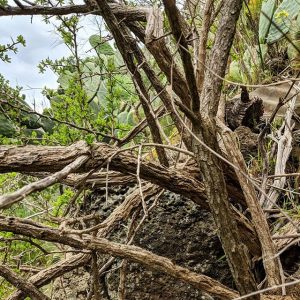African boxthorn (Lycium ferocissimum) in all its dread angles, a declared weed of national significance.
A nightshade native to the Cape provinces of South Africa, African boxthorn was introduced intentionally to Australia in the second half of the nineteenth century as a fast-growing living fence resistant to cattle, said to be an economical substitute for post-and-rail and hawthorn hedge alike. Consider this glowing appraisal, one of the earliest, published in Melbourne’s Leader newspaper in 1873: “The boxthorn has no disadvantages that the whitethorn [hawthorn] does not also possess… the boxthorn has the advantage in every way. The whitethorn of quick growth throws out no prickles, while the boxthorn of equal growth, on every inch of the branch, has prickles strong enough to pierce the hide of an elephant… When both plants are switched, or cut back, the thickening properties of the box are far superior, and the power to resist cattle three times as great… an ounce of seed will produce as many plants as would run nearly one mile of fence, and what is of more importance in this country is its power to resist drought.”
Planted in Victoria from at least the mid-1860s, boxthorn was heavily promoted by local columnists in the 1870s; the hype spread to papers in other states by late in that decade. The promise of a cheap alternative to hawthorn or Osage Orange as living fences proved a decisive allure, even as some among the plant’s breathless promoters did acknowledge that “an objection to it is that the shed seed grows all about and forms weeds” (Leader, 25/04/1874).
Today, this plant is one of the country’s worst weeds, an environmental invader that has a significant impact on native plants, birds and mammals, an occupier of agricultural land and a safe harbour to pests, and a severe long-term injury threat to livestock, native animals and people.
1-4: Mature plants on Merri Creek bluffs; 5-9: A younger plant in abandoned landscaping out front of a Dynon Rd business; 10 The 2 cm reason that I will never again get close to boxthorn without body armour.
View Original Post on Instagram
Search for information about Lycium ferocissimum in the Flora of Victoria
View information and occurrences of Lycium ferocissimum on the Atlas of Living Australia











